Star of India (flag)
The Star of India refers to a group of flags used during the period of the British Raj in the Indian subcontinent.[1][2][3] British India had a range of flags for different purposes during its existence. The Princely states had their own flags which were to be flown alongside the British flag as a symbol of suzerainty. The official state flag for use on land was the Union Flag of the United Kingdom and it was this flag that was lowered on Independence Day in 1947. The flag of the Governor-General of India was defaced with the Star of India. The civil ensign and naval ensign were the Red Ensign or Blue Ensign, respectively, defaced with the Star of India emblem.
.svg.png.webp) | |
| Name | Flag of the Viceroy and Governor-General of India |
|---|---|
| Proportion | 1:2 |
| Adopted | 1885–1947 |
| Design | Union Jack with the Order of the Star of India in the center, surmounted by the Tudor Crown. |
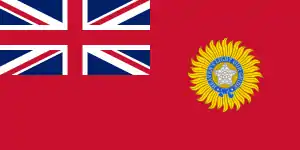 Variant flag of Indian Empire | |
| Use | Civil ensign |
| Proportion | 1:2 |
| Adopted | 1880–1947 |
| Design | Red Ensign with the Union Jack occupying one quarter of the field placed in the canton and defaced with the Order of the Star of India. |
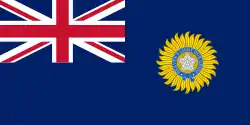 Variant flag of Indian Empire | |
| Use | Naval ensign |
| Proportion | 1:2 |
| Adopted | 1879–1947 |
| Design | Blue Ensign with the Union Jack occupying one quarter of the field placed in the canton and defaced with the Order of the Star of India. |
History
Ideas for a flag for areas under British India were initially imperial ones, rather than nationalist ones. After the Indian Rebellion of 1857 and the later establishment of the British Raj, a representative symbol of the new government was pending. Various designs were proposed for the first Star of India flag in 1863, keeping similar flag designs adopted in other British colonies such as Canada and Australia, combining symbols of Imperial authority such as the Union Jack, the royal crown, with symbols specific to the colony in question. [4]
Company flag
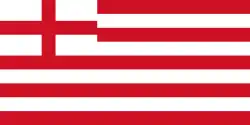 Flag of the East India Company from 1600 to 1707.
Flag of the East India Company from 1600 to 1707..svg.png.webp) Flag of the East India Company from 1707 to 1801.
Flag of the East India Company from 1707 to 1801..svg.png.webp) Flag of the East India Company from 1801 to 1858.
Flag of the East India Company from 1801 to 1858.
Upon receiving Royal Assent to trade in the Indian Ocean by Queen Elizabeth I in 1600, the English East India Company adopted a flag of thirteen red and white stripes with the flag of England in canton.
After the Indian Rebellion of 1857, the British government passed the Government of India Act 1858, nationalising the East India Company and taking over all of their possessions within India, where they would be considered legally a part of the British Raj. The striped banner of the Company was thus replaced by the Union Jack.
Flags
Blue Ensign
 Ensign of the Royal Indian Marine (later called the Royal Indian Navy).
Ensign of the Royal Indian Marine (later called the Royal Indian Navy)..png.webp) Photograph of the Blue Ensign, used as the naval jack of the Royal Indian Navy
Photograph of the Blue Ensign, used as the naval jack of the Royal Indian Navy
After Queen Victoria became Empress of India through the proclamation of 1876, a naval ensign with the symbol of the Order of the Star of India was warranted by the Admiralty to the Indian Marine in 1877. It was used on vessels of Her Majesty's Indian Marine (Later called the Royal Indian Navy) and for other military and naval purposes.
Its usage was altered from 1928, when the Royal Indian Navy switched to White Ensign as naval ensign, and the Blue Ensign became the naval jack.
Red Ensign
 Civil ensign of British India, which was also sometimes used to represent India internationally.
Civil ensign of British India, which was also sometimes used to represent India internationally. A Somerset Light Infantry Regiment member hoists the Civil Ensign
A Somerset Light Infantry Regiment member hoists the Civil Ensign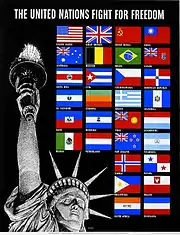 The Red Ensign used to represent India as a member of the Allies in World War II, showing the original United Nations in 1942
The Red Ensign used to represent India as a member of the Allies in World War II, showing the original United Nations in 1942
While the Blue Ensign was used for military and naval purposes, the Red Ensign was used as the civil ensign and sometimes represented India in international events, notably in the Declaration by United Nations during World War II. The ensign used on merchant ships registered in British Indian ports was the undefaced red ensign.[3]
Flag of the Viceroy and Governor-General
.svg.png.webp) Flag of the Viceroy and Governor-General of India.
Flag of the Viceroy and Governor-General of India.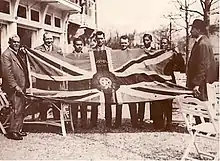 Indian hockey players arrive in the Netherlands for the 1928 Summer Olympics
Indian hockey players arrive in the Netherlands for the 1928 Summer Olympics Flag of the Viceroy of India being used to represent India at the 1936 Summer Olympics
Flag of the Viceroy of India being used to represent India at the 1936 Summer Olympics
From around 1885, the Viceroy of India was allowed to fly a Union Flag augmented in the centre with the 'Star of India' surmounted by a Crown. It was often used to represent India, acting as an "unofficial national flag", in international events etc. This flag was not the Viceroy's personal flag; it was also used by Governors, Lieutenant Governors, Chief Commissioners and other British officers in India. When at sea, only the Viceroy flew the flag from the mainmast, while other officials flew it from the foremast.
.svg.png.webp) Flag of the Governor-General of the Dominion of India (1947-1950).
Flag of the Governor-General of the Dominion of India (1947-1950)..svg.png.webp) Flag of the Governor-General of the Dominion of Pakistan (1947-1953).
Flag of the Governor-General of the Dominion of Pakistan (1947-1953)..svg.png.webp) Flag of the Governor-General of the Dominion of Pakistan (1953-1956).
Flag of the Governor-General of the Dominion of Pakistan (1953-1956).
The Star of India series of flags were discontinued from 1947, when the newly independent Dominions of India and Pakistan were established by the Indian Independence Act 1947. The newly formed offices of the Governor-Generals of India and Pakistan used a dark blue flag bearing the royal crest (a lion standing on the Tudor Crown), beneath which were the words 'INDIA' and 'PAKISTAN' in gold majuscules respectively.
These flags were ultimately discontinued when India and Pakistan when they abolished their Dominion status after becoming constitutional republics in 1947 and 1956 respectively.
Flag of British Indian Army
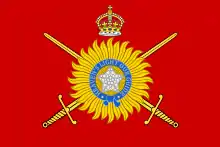 Ensign of the British Indian Army
Ensign of the British Indian Army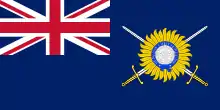 Flag of the British Indian Army
Flag of the British Indian Army
The British Indian Army used red field emblazoned with Star of India crossed by two swords and beneath the Tudor Crown as ensign and a blue ensign with the Union Flag defaced at the canton, and the Star of India crossed by two swords displayed in the fly as war flag from 1895 to 1947.
Proposed flags
Lord Mountbatten, the last Viceroy of India in 1947 proposed two separate flags for India and Pakistan to be used after Partition of India. The flag for India consisted of the flag of the Indian National Congress defaced with a Union Jack in the canton. It was rejected by Nehru, as he felt that the more extremist members of Congress would see the inclusion of the Union Jack on an Indian flag as pandering to the British. The flag for Pakistan consisted of the flag of the Muslim League defaced with a Union Jack in the canton. It was rejected by Jinnah, as he felt that a flag featuring a Christian Cross alongside the Islamic Crescent would be unacceptable to the Muslims of Pakistan.
Flag of Home Rule
- Home Rule flag variants
Indian Home Rule movement used a five red and four green horizontal stripes flag. On the upper left quadrant was the Union Flag, which signified the Dominion status that the movement sought to achieve. A crescent and a seven-pointed star, both in white, are set in top fly. Seven white stars are arranged as in the Saptarishi constellation (the constellation Ursa Major), which is sacred to Hindus. [Note 1]
Emblem
| Star of India | |
|---|---|
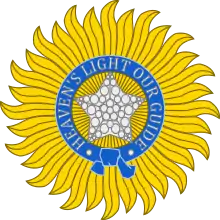 | |
| Armiger | Emperor/Empress of India Viceroy of India |
| Adopted | 1861 |
| Blazon | Silver five pointed star encircled by a blue ribbon bearing the motto of the order atop a gold sunburst. |
| Motto | "Heaven's Light Our Guide" |
| Order(s) | Order of the Star of India |
| Use | Emblem of the Indian Empire, alongside the Coat of Arms of the United Kingdom |
.svg.png.webp) Badge of the Viceroy of India (1876-1904) with St Edward's Crown
Badge of the Viceroy of India (1876-1904) with St Edward's Crown Badge of the Viceroy of India (1904-1947) with Tudor Crown
Badge of the Viceroy of India (1904-1947) with Tudor Crown
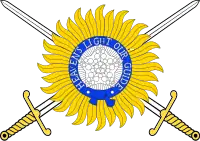 Badge of the British Indian Army (1895-1947)
Badge of the British Indian Army (1895-1947)
The Star of India was the symbol of the Order of the Star of India, a chivalric order of knighthood. It was a sunburst with twenty-six large rays alternating with twenty-six small rays. In the centre of the sunburst was a light blue ribbon bearing the motto of the Order, Heaven's Light Our Guide. Within the ribbon was a five-pointed star, decorated with diamonds. The motto chosen was neutral so as to appeal to people of different faiths due to the religious diversity of India, with Heaven also referring to the stars, and their light that sailors used to circumnavigate to India. Unlike most British symbols, the Star did not have Christian connotations, as they were deemed unacceptable to the Indian Princes.
Legacy
The flags were replaced by the Tiraṅgā (Indian Tricolour) after Independence on 15 August 1947 in the independent Dominion of India, and by the Flag of Pakistan in the independent Dominion of Pakistan, which used the star as the basis of its Coat of Arms.
The emblem was used as a basis for many emblems of British India and continues to be used in modern India. The emblem is still used as a basis for the logos of many organisations such as The Oriental Insurance Company, Board of Control for Cricket in India, Indian Olympic Association, Mumbai Police etc.
 Insignia of Khatau Mills, Bombay.
Insignia of Khatau Mills, Bombay. Logo of The Oriental Insurance Company, which draws heavy inspiration from the Star of India
Logo of The Oriental Insurance Company, which draws heavy inspiration from the Star of India
List of flags used in British India
| Flag | Date | Description |
|---|---|---|
.svg.png.webp) | 1733–1858 | Flag of the Governors of the Presidency of Fort William (Bengal). Flag of the East India Company. |
 | 1858–1947 | Flag of the United Kingdom, the official flag of the British Empire. |
.svg.png.webp) | 1885–1947 | Flag of the Viceroy and Governor-General of India. Often used to represent India in international events etc. |
 | 1880–1947 | Civil ensign of British India, which was also sometimes used to represent India internationally. |
 | 1879–1947 | 1879–1928 Naval ensign of the Indian Marine (later called the Royal Indian Marine) 1928–1947 Naval jack of the Royal Indian Marine (later called the Royal Indian Navy). |
 | 1884–1928 | Naval jack of the Royal Indian Marine (later called the Royal Indian Navy). |
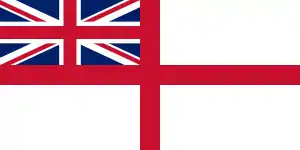 | 1928–1950 | Ensign of the Royal Indian Marine (later called the Royal Indian Navy). Same as the White Ensign of the Royal Navy. |
 | 1895–1947 | Ensign of the British Indian Army. |
Notes
- In 1916, Suraiya Tayyabji submitted thirty new designs, in the form of a booklet funded by members of the High Court of Madras. These many proposals and recommendations did little more than keep the flag movement alive. The same year, Annie Besant and Bal Gangadhar Tilak adopted a new flag as part of the Home Rule Movement. The flag included the Union Jack in the upper left corner, a star and crescent in the upper right, and seven stars displayed diagonally from the lower right, on a background of five red and four green alternating bands. The flag resulted in the first governmental initiative against any nationalistic flag, as a magistrate in Coimbatore banned its use. The ban was followed by a public debate on the function and importance of a national flag.[5]
References
- "The Book of Flags". Oxford University Press. Gordon Campbell & Idrisyn Oliver Evans. 1965.
- "8th/13th Victorian Mounted Rifles Regimental Collection". Victorian Collections. Museums Victoria, Victorian State Government. 14 Dec 2017.
- "FLAGS OF THE BRITISH RAJ & THE INDIAN PRINCELY STATES". War Flags Glossary. Thomas M. Gregg. 7 February 1999.
- Roy, Srirupa (2002). "A symbol of freedom: The Indian flag and the transformations of nationalism" (PDF). The Journal of Asian Studies. Retrieved 4 July 2019. Cite journal requires
|journal=(help) - Virmani, Arundhati (August 1999). "National Symbols under Colonial Domination: The Nationalization of the Indian Flag, March–August 1923". Past & Present. 164 (164): 176–177. doi:10.1093/past/164.1.169. JSTOR 651278.
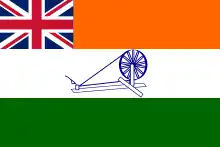
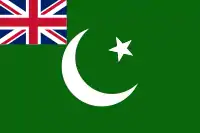

.jpg.webp)
.png.webp)